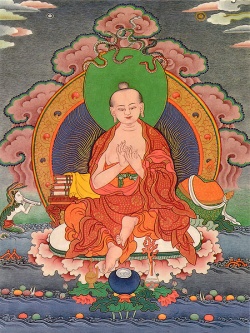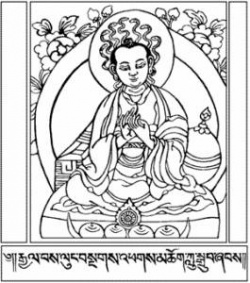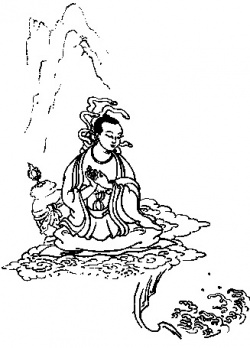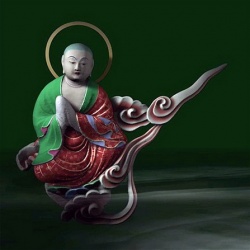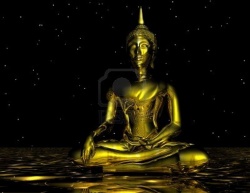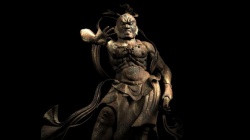Nagarjuna’s Life, Legend and Works
1. The philosophy of Nagarjuna's Middle Way in the context of the Four Noble Truths. - Thomas J. McFarlane
The First Noble Truth: there is suffering, the world is impermanent. In our terms, this truth expresses the mundane truth that all things are empty of inherent existence, they are conditioned and relative. Because we cling to them as if they were permanent and substantial, suffering is the inevitable consequence.
The Second Noble Truth: there is a cause of suffering. The cause of suffering is clinging to the relative as absolute, the conditioned as unconditioned, the insubstantial as substantial. The ignorance of the true emptiness or sunya-nature of things, the confusion of the real and unreal, is the root error that leads to all suffering.
The Third Noble Truth: there is an end to suffering. Because even emptiness is empty, because relativity and conditionedness themselves are not absolute, suffering is not ultimate. While the mundane nature of the conditioned is conditionedness, yet in its ultimate nature, the conditioned is itself the undivided, unconditioned reality. While the ultimate reality is beyond the distinctions that hold in the world of the determinate, yet the ultimate reality is not wholly separate from the determinate, but is the real nature of the determinate itself. It is because we already are identical to the unconditioned reality that we can recognize this truth and become liberated from the imagination that we are otherwise, and thereby end our suffering.
The Fourth Noble Truth: there is a path that leads to the end of suffering. The Middle Way is the non-exclusive way that destroys the ignorance of clinging to the relative as absolute. Through the method of criticism, extreme views are shown to lead to contradictions which reveal the truth of sunyata with regard to all things. Ultimately, even sunyata or relativity itself is denied as absolute, revealing the unutterable unconditioned reality which is the ultimate nature of ourselves and all things.
2. Nagarjuna (c. 150-250) -
Often referred to as “the second Buddha” by Tibetan and East Asian Mahayana (Great Vehicle) traditions of Buddhism, Nagarjuna proffered trenchant criticisms of Brahminical and Buddhist substantialist philosophy, theory of knowledge and approaches to practice. Nagarjuna’s central concept of the “emptiness (sunyata) of all things (dharmas),” which pointed to the incessantly changing and so never fixed nature of all phenomena, served as much as the terminological prop of subsequent Buddhist philosophical thinking as the vexation of opposed Vedic systems. The concept had fundamental implications for Indian philosophical models of causation, substance ontology, epistemology, conceptualizations of language, ethics and theories of world-liberating salvation, and proved seminal even for Buddhist philosophies in India, Tibet, China and Japan very different from Nagarjuna’s own. Indeed it would not be an overstatement to say that Nagarjuna’s innovative concept of emptiness, though it was hermeneutically appropriated in many different ways by subsequent philosophers in both South and East Asia, was to profoundly influence the character of Buddhist thought.
Nagarjuna’s Life, Legend and Works
Precious little is known about the actual life of the historical Nagarjuna. The two most extensive biographies of Nagarjuna, one in Chinese and the other in Tibetan, were written many centuries after his life and incorporate much lively but historically unreliable material which sometimes reaches mythic proportions. However, from the sketches of historical detail and the legend meant to be pedagogical in nature, combined with the texts reasonably attributed to him, some sense may be gained of his place in the Indian Buddhist and philosophical traditions.
Nagarjuna was born a “Hindu,” which in his time connoted religious allegiance to the Vedas, probably into an upper-caste Brahmin family and probably in the southern Andhra region of India. The dates of his life are just as amorphous, but two texts which may well have been authored by him offer some help. These are in the form of epistles and were addressed to the historical king of the northern Satvahana dynasty Gautamiputra Satakarni (ruled c. 166-196 CE), whose steadfast Brahminical patronage, constant battles against powerful northern Shaka Satrap rulers and whose ambitious but ultimately unsuccessful attempts at expansion seem to indicate that he could not manage to follow Nagarjuna’s advice to adopt Buddhist pacifism and maintain a peaceful realm. At any rate, the imperial correspondence would place the significant years of Nagarjuna’s life sometime between 150 and 200 CE. Tibetan sources then may well be basically accurate in portraying Nagarjuna’s emigration from Andhra to study Buddhism at Nalanda in present-day Bihar, the future site of the greatest Buddhist monastery of scholastic learning in that tradition’s proud history in India. This emigration to the north perhaps followed the path of the Shaka kings themselves. In the vibrant intellectual life of a not very tranquil north India then, Nagarjuna came into his own as a philosopher.
The occasion for Nagarjuna’s “conversion” to Buddhism is uncertain. According to the Tibetan account, it had been predicted that Nagarjuna would die at an early age, so his parents decided to head off this terrible fate by entering him in the Buddhist order, after which his health promptly improved. He then moved to the north and began his tutelage. The other, more colorful Chinese legend, portrays a devilish young adolescent using magical yogic powers to sneak, with a few friends, into the king’s harem and seduce his mistresses. Nagarjuna was able to escape when they were detected, but his friends were all apprehended and executed, and, realizing what a precarious business the pursuit of desires was, Nagarjuna renounced the world and sought enlightenment. After having been converted, Nagarjuna’s adroitness at magic and meditation earned him an invitation to the bottom of the ocean, the home of the serpent kingdom. While there, the prodigy initiate “discovered” the “wisdom literature” of the Buddhist tradition, known as the Prajnaparamita Sutras, and on the credit of his great merit, returned them to the world, and thereafter was known by the name Nagarjuna, the “noble serpent.”
Despite the tradition’s insistence that immersion into the scriptural texts of the competing movements of classical Theravada and emerging “Great Vehicle” (Mahayana) Buddhism was what spurred Nagarjuna’s writings, there is rare extended reference to the early and voluminous classical Buddhist sutras and to the Mahayana texts which were then being composed in Nagarjuna’s own language of choice, Sanskrit. It is much more likely that Nagarjuna thrived on the exciting new scholastic philosophical debates that were spreading throughout north India among and between Brahminical and Buddhist thinkers. Buddhism by this time had perhaps the oldest competing systematic worldview on the scene, but by then Vedic schools such as Samkhya, which divided the cosmos into spiritual and material entities, Yoga, the discipline of meditation, and Vaisesika, or atomism were probably well-established. But new and exciting things were happening in the debate halls. A new Vedic school of Logic (Nyaya) was making its literary debut, positing an elaborate realism which categorized the types of basic knowable things in the world, formulated a theory of knowledge which was to serve as the basis for all claims to truth, and drew out a full-blown theory of correct and fallacious logical argumentation. Alongside it, within the Buddhist camp, sects of metaphysicians emerged with their own doctrines of atomism and fundamental categories of substance. Nagarjuna was to undertake a forceful engagement of both these new Brahminical and Buddhist movements, an intellectual endeavor till then unheard of.
Nagarjuna saw in the concept sunya, a concept which connoted in the early Pali Buddhist literature the lack of a stable, inherent existence in persons, but which since the third century BCE had also denoted the newly formulated number “zero,” the interpretive key to the heart of Buddhist teaching, and the undoing of all the metaphysical schools of philosophy which were at the time flourishing around him. Indeed, Nagarjuna’s philosophy can be seen as an attempt to deconstruct all systems of thought which analyzed the world in terms of fixed substances and essences. Things in fact lack essence, according to Nagarjuna, they have no fixed nature, and indeed it is only because of this lack of essential, immutable being that change is possible, that one thing can transform into another. Each thing can only have its existence through its lack (sunyata) of inherent, eternal essence. With this new concept of “emptiness,” “voidness,” “lack” of essence, “zeroness,” this somewhat unlikely prodigy was to help mold the vocabulary and character of Buddhist thought forever.
Armed with the notion of the “emptiness” of all things, Nagarjuna built his literary corpus. While argument still persists over which of the texts bearing his name can be reliably attributed to Nagarjuna, a general agreement seems to have been reached in the scholarly literature. Since it is not known in what chronological order his writings were produced, the best that can be done is to arrange them thematically according to works on Buddhist topics, Brahminical topics and finally ethics Addressing the schools of what he considered metaphysically wayward Buddhism, Nagarjuna wrote Fundamental Verses on the Middle Way (Mulamadhyamakakarika), and then, in order to further refine his newly coined and revolutionary concept, the Seventy Verses on Emptiness (Sunyatasaptati), followed by a treatise on Buddhist philosophical method, the Sixty Verses on Reasoning (Yuktisastika).. Included in the works addressed to Buddhists may have been a further treatise on the shared empirical world and its establishment through social custom, called Proof of Convention (Vyavaharasiddhi), though save for a few cited verses, this is lost to us, as well as an instructional book on practice, cited by one Indian and a number of Chinese commentators, the Preparation for Enlightenment (Bodhisambaraka). Finally is a didactic work on the causal theory of Buddhism, the Constituents of Dependent Arising (Pratityasumutpadahrdaya). Next came a series of works on philosophical method, which for the most part were reactionary critiques of Brahminical substantialist and epistemological categories, The End of Disputes (Vigrahavyavartani) and the not-too-subtly titled Pulverizing the Categories (Vaidalyaprakarana). Finally are a pair of religious and ethical treatises addressed to the king Gautamiputra, entitled To a Good Friend (Suhrlekha) and Precious Garland (Ratnavali). Nagarjuna then was a fairly active author, addressing the most pressing philosophical issues in the Buddhism and Brahmanism of his time, and more than that, carrying his Buddhist ideas into the fields of social, ethical and political philosophy.
It is again not known precisely how long Nagarjuna lived. But the legendary story of his death once again is a tribute to his status in the Buddhist tradition. Tibetan biographies tell us that, when Gautamiputra’s successor was about to ascend to the throne, he was anxious to find a replacement as a spiritual advisor to better suit his Brahmanical preferences, and unsure of how to delicately or diplomatically deal with Nagarjuna, he forthrightly requested the sage to accommodate and show compassion for his predicament by committing suicide. Nagarjuna assented, and was decapitated with a blade of holy grass which he himself had some time previously accidentally uprooted while looking for materials for his meditation cushion. The indomitable logician could only be brought down by his own will and his own weapon. Whether true or not, this master of skeptical method would well have appreciated the irony.
3. Seventy Verses on Emptiness - Nagarjuna - Note: This version of Seventy Verses on Emptiness displayed here is an edited version by David Quinn, based on a translation by Peter Della Santina.
Duration, origination, destruction, existence, non-existence, inferiority, mediocrity and superiority were taught by the Buddha in accord with conventional usage, not by the power of the real.
There is not anything which corresponds to the expressions: not-self, not not-self, both self and not-self, because all factors which can be spoken of are -- like Nirvana -- empty in their intrinsic being.
Since the intrinsic being of all entities does not exist in their causes and conditions, either together or separately, or in any way at all, they are empty.
The existent does not originate because it is existent. The non-existent does not originate because it is non-existent. The existent and non-existent also does not originate because they are heterogeneous. Because there is no origination, there is no duration and no destruction.
The originated is not the object to be originated. The unoriginated is also not the object to be originated. The object at the time of origination is also not the object to be originated, because it would be originated and unoriginated.
If the effect is existent, the cause will possess the effect. If nonexistent, the cause will be equal to a non-cause. If neither existent nor non-existent, it is contradictory. Nor again is a cause justified in the three times [past, present and future].
Without one, many does not occur. Without many, one does not occur. Therefore, interdependently originated entities are without form and attributes.
How can what is not established in its own intrinsic being produce another? A condition which is not established cannot cause the origination of another.
The father is not the son, nor is the son the father, nor do they exist without mutual dependence, nor are they identical. The same is true for the twelve constituents.
Neither the happiness and suffering which depend upon an object in a dream, nor that object itself, are existent. Similarly, neither that which originates dependently, nor that upon which it depends, are existent.
If entities are not existent in their intrinsic being, then neither inferiority, mediocrity nor superiority, nor the manifold objects of experience as such, are existent.
If neither origination nor cessation are existent, then Nirvana is the cessation of what exactly? What neither originates nor ceases - is this not liberation?
If Nirvana were cessation, it would be annihilation. If it were otherwise, it would be permanence. Therefore, Nirvana is neither being nor non-being. It neither originates, nor ceases.
The characteristic is established by the substratum of the characteristic. The substratum of the characteristic is established by the characteristic, but they are not established independently, nor are they established by one another. What is not established is not that which establishes another which is not established.
By this analysis, cause and effect, experience and the subject of experience, as well as the subject and object of vision, hearing, etc, -- indeed, whatever may exist -- are all explained without exception.
The three times are non-existent and are mere imagination. They are non-enduring, reciprocally established, disordered, not established independently and thus, like all entities, non-existent.
Because the three characteristics of the compounded object -- origination, duration and destruction -- are non-existent, the compounded and the uncompounded are also non-existent.
The compounded and the uncompounded are neither manifold nor unitary, neither existent nor non-existent, nor both existent and non-existent. Within this perimeter, all possibilities are included.
The Blessed One proclaimed the enduring nature of actions. He proclaimed actions and their effects. He proclaimed that the sentient being is the agent of actions and that actions are not lost.
Because it has been demonstrated that they are without intrinsic being, actions do not originate, so they cannot be destroyed. Actions originate from self-clinging. That clinging which produces actions also originates from imagination.
If actions existed in their intrinsic being, then the body originated from them would be permanent. They would not be endowed with the maturing effect of suffering. Therefore, actions would also be substantial.
Actions originated from conditions are not in the least existent, nor are actions originated without conditions existent. Compounded objects and events are like an illusion, a fairy city and a mirage.
Afflictions are the cause of actions. Volition consists of actions and afflictions. Actions are the cause of the body, therefore all three are empty in their intrinsic being.
Without actions, there is no agent. Without those two, there is no effect. Without an effect, there is consequently no subject of experience. Hence, they are all empty.
If one knows very well actions to be empty, actions will not originate, simply because of this perception of reality. Without actions, that which originates from actions will not originate.
As the Blessed One, the Tathagata creates an illusory creation by means of illusory emanation, that illusory creation creates another illusory creation.
Among them, the illusory creation that is the Tathagata is also empty. What need is there to say anything about the illusory creation of an illusory creation? They are both existent insofar as anything which is mere imagination.
Similarly, the agent is like the illusory creation, and actions are like the illusory creation of an illusory creation. They are empty in their intrinsic being and exist insofar as anything which is mere imagination.
If actions existed in their intrinsic being, there would be no Nirvana and no agent of actions. If they were non-existent, there would be no attractive and unattractive effects originated from actions.
There exists the statement of existence and also the statement of non-existence and again the statement of both existence and non-existence. The intentional proclamations of the Buddhas are not easily penetrated.
If awareness apprehended form, it would be apprehended as the very intrinsic being of awareness. How could non-existent awareness originated from conditions apprehend non-existent form?
When the originated momentary awareness does not apprehend the originated momentary form, how could it comprehend past and future form?
While colour and shape never exist separately, the separate are not apprehended as one, because the two are known as form.
Eye awareness is not existent in the eye. It is not existent in form, nor in the space in between. What is constructed dependent upon the eye and form is erroneous.
If the eye does not see itself, how can it see form? Therefore, the eye and form are insubstantial. The remaining sense spheres are also similar.
The eye is empty of its own substantiality. It is empty of another's substantiality. Similarly, form is also empty, and also the remaining sense spheres.
Consciousness originates dependent upon an object of consciousness, therefore it is non-existent. Without cognition and an object of consciousness, there is consequently no consciousness at all.
All is impermanent, but impermanence or permanence never existed. If an entity existed, it would be impermanent or permanent, but how can it exist in the first place?
Born from the conditions of attraction, repulsion and error, attachment, aversion and delusion originate. Therefore, attachment, aversion and delusion are non-existent in their intrinsic being.
The object of imagination is not existent. Without the object of imagination, how is imagination existent? Therefore, since they are originated from conditions, the object of imagination, and imagination itself, are empty.
When there is perception of the real, no ignorance originates from the four erroneous views. Since that ignorance is non-existent, volitions do not originate.
Whatever originates dependent upon that, originates from that. Without that, it does not originate. Entities and non-entities as well as compounded factors and uncompounded factors are peace and Nirvana.
Entities originated from causes and conditions are imputed by ordinary people to be real. That is proclaimed to be ignorance by the Buddha.
When there is perception of the real, of entities as empty, ignorance does not originate. Just that is the cessation of ignorance. When that happens, the twelve constituents cease.
Compounded objects and events are like a fairy city, an illusion, a mirage, a bubble of water, foam and like a dream and the circle of the whirling fire-brand.
No entity whatsoever is existent in its intrinsic being. Entities and non-entities originated from causes and conditions are empty.
Since all entities are empty in their intrinsic being, the Interdependent Origination of entities is demonstrated by the incomparable Tathagata.
The ultimate is none other than this Emptiness. The Blessed Buddha, relying upon conventional usage, imagined all possibilities.
The doctrine of the world is not destroyed. In reality, no factor at all is demonstrated. Not comprehending the proclamation of the Tathagata, ordinary people are consequently afraid of the unsupported and unimaginable truth.
The way of the world, "dependent upon this, that originates", is not negated. What is interdependently originated is without intrinsic being, so how does it exist? This is perfect certitude.
One who has faith, who diligently seeks the ultimate, not relying upon any demonstrated factor, inclined to subject the way of the world to reason, abandoning being and non-being attains peace.
Having comprehended apparent conditionality, the net of false views is swept aside. Consequently, abandoning attachment, delusion and anger, without stain, one surely reaches Nirvana.
4. Buddha's Grove
Welcome to the Buddha's Grove. Inspired by the Jeta's Grove where Sakyamuni Buddha (the original Buddha) held many of his most important talks 2500 years ago, this site offers a handful of leaves that is the Buddha's teachings, the Buddhadharma, plucked from the spirit of the ancient Grove, as written by old famous masters and students as well as contemporary ones. The teachings of the Buddhadharma are vaster than any website can publish, but this humble presentation of leaves will hopefully be able to aid the new and experienced practitioners alike on their way.
In creating this website, I've strived for simplicity and clarity, in layout as well as visually, to ease the eyes and mind of the reader. The aim of this site is of course to help Buddhist practitioners as much as possible with a selection of the best Buddhist writings available on the internet, and if you feel that something is missing or you might have something to contribute, any submissions would be appreciated.
The Poetry & Stories section should set you in the right spirit of the Grove and this is the place to enjoy a selection of famous and not-so-famous Dharma paintings with words, or relax with a good short story. A poem or story can capture the essence of the Dharma in ways that are not possible otherwise, so don't let this opportunity pass by.
In the Theravada Writings section you'll find the teachings of the Buddha in its most ancient and preserved incarnation, Theravada traditionally being the school that upholds the original teachings of the Buddha, although much of the material is written by contemporary authors of that tradition, especially of the Forest Tradition.
In the Zen / Ch'an Writings section you'll find the teachings of the Zen (Chinese: Ch'an) school, but only the teachings of the old masters which have been acknowledged as canon, in order to ensure authenticity, in a time where the wisdom of many contemporary masters have been brought into question. As Zen is often said to be a symbiosis of Buddhism and Taoism, and also draws from Taoist scriptures for wisdom, a selection of classics from the Taoist Canon has also been included.
The Other Mahayana Writings contains all generic Mahayana teachings, such as sutras, shastras and so forth, as well as the teachings of the Non-Zen Mahayana schools on this website. I have put a special emphasis on the Dzogchen and Mahamudra traditions of Vajrayana to meet the popularity of just these schools, and surely these will prove of special interest to Zen students as well, who will note the striking similarity with the Zen Path, especially that of the Cao Dong (Silent Illumination) and Soto sects. As with the Zen section, I have tried to stick with the 'canon' teachers of the past, to ensure the authenticity of the Dharma presented on this website.
Don't take all these divisions so seriously though. Some Theravada leaves are just as much Zen as they are Theravada and vice versa. Basically, they are all Dharma leaves, so please visit all sections no matter what tradition you uphold. As it is written in the famous Zen poem the Song of Enlightenment:
"If someone asks, what is your sect, And how do you understand it?
I reply, the power of tremendous prajna."
And that is something that cannot be defined or confined by any sect.
Before you leave the Grove, stop by the Buddhist Links & Webrings pages, which will take you further into the Buddhist internet community. Be sure to check the Updates & News section when you return to see what's been added since your last visit.
So come on, listen to the chatter of birds, feel the sun shining through the cluster of trees warming your travel-worn body, sit down and relax in the Buddha's Grove. Hopefully, you'll leave a little bit wiser than when you came. - Anders Honoré.

